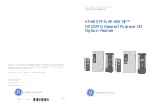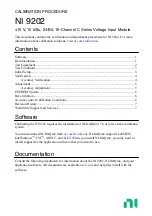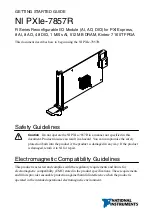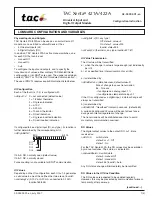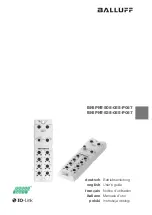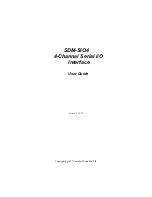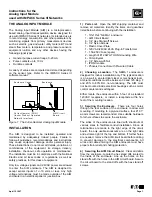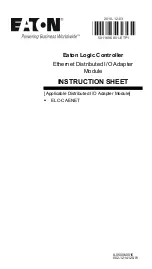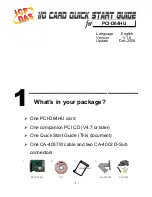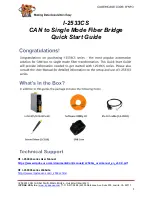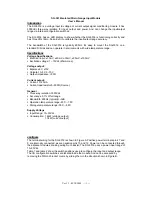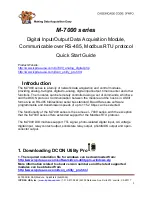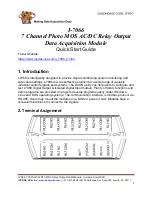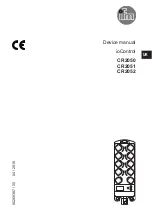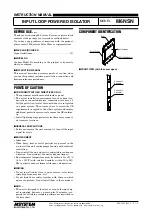
1 | Overview
The module’s address switches provide a tens and ones value
for the module’s address. For single-digit address numbers 1
through 9, set the tens switch to 0 and the ones digit to the
appropriate number.
Figure 2.1
shows the address switches
setting for addresses 1 and 11.
Set the address switches per the control panel configuration. If
multiple B208 modules reside on the same system, each B208
module must have a unique address.
Callout ― Description
1 ― Module with mounting bracket installed
2 ― Enclosure
3 ― Mounting screws (3)
3.1 | Mount the module in the enclosure
Mount the module into the enclosure’s 3-hole mounting
pattern using the supplied mounting screws and mounting
bracket. Refer to
Figure 3.1
.
Figure 3.1: Mounting the module in the enclosure
3 | Installation
After you set the address switches for the proper address,
install the module in the enclosure, and then wire it to the
control panel.
CAUTION!
Remove all power (AC and battery) before making any
connections. Failure to do so might result in personal
injury and/or equipment damage.
3.2 | Mount and wire the tamper switch
You can connect an optional enclosure door tamper switch
for one module in an enclosure.
Installing the optional tamper switch:
1. Mount the ICP-EZTS Tamper Switch (P/N: F01U009269)
into the enclosure’s tamper switch mounting location.
For complete instructions, refer to
EZTS Cover and Wall
Tamper Switch Installation Guide
(P/N: F01U003734).
2. Plug the tamper switch wire onto the module’s tamper
switch connector. Refer to
Figure 1.1
.
3.3 | Wire to the control panel
When you wire the module to a control panel, you can use either
the module’s terminal strip labeled with PWR, A, B, and COM,
or the module’s interconnect wiring connectors (wire included).
Interconnect wiring parallels the PWR, A, B, and COM terminals
on the terminal strip.
Figure 1.1
indicates the location of both
the terminal strip and the interconnect connectors on the
module. Refer to
Figures 3.2
,
3.3
, and
3.4
.
NOTICE!
Use either the terminal strip wiring
or
interconnect
wiring connector to the control panel. Do not use
both. When connecting multiple modules, you can
combine terminal strip and interconnect wiring
connectors in series.
Figure 3.2: Using terminal strip or interconnect cable wiring
D9412GV4 shown)
Callout ― Description
1 ― Terminal strip wiring (SDI2)
2 ― Interconnect cable (P/N: F01U079745) (included)
Figure 3.3: Installing multiple modules using the SDI2 terminal
strip (D9412GV4 shown)
Callout ― Description
1 ― Bosch control panel
2 ― B208 modules
Figure 3.4: Installing multiple modules using the SDI2
interconnect wiring connector (D9412GV4 shown)
Callout ― Description
1 ― Bosch control panel
2 ― B208 modules
NOTICE!
The module reads the address switch setting only
during power up. If you change the switches after
you apply power to the module, you must cycle the
power to the module to enable the new setting.
Two address switches determine the address for the B208
Octo-input Module. The control panel uses the address for
communications. The address also determines the output
numbers. Use a slotted screwdriver to set the two address
switches.
Figure 2.1: Address switches
2.1 | Valid addresses and input numbers per
control panel
Valid B208 addresses are dependent on the number of points
allowed by a particular control panel. Addresses higher than 32
require B208 firmware version 1.03.003 or higher.
Control
panel
Valid
B208
addresses
Corresponding point
numbers
B9512G
01 - 59
11 - 18, 21 - 28, 31 - 38, 41 - 48,
51 - 58, 61 - 68, 71 - 78,
81 - 88, 91 - 98, 101 - 108,
111 - 118, 121 - 128, 131 - 138,
141 - 148, 151 - 158, 161 - 168,
171 - 178, 181 - 188, 191 - 198,
201 - 208, 211 - 218, 221 - 228,
231 - 238, 241 - 248, 251 - 258,
261 - 268, 271 - 278, 281 - 288,
291 - 298, 301 - 308, 311 - 318,
321 - 328, 331 - 338, 341 - 348,
351 - 358, 361 - 368, 371 - 378,
381 - 388, 391 - 398, 401 - 408,
411 - 418, 421 - 428, 431 - 438,
441 - 448, 451 - 458, 461 - 468,
471 - 478, 481 - 488, 491 - 498,
501 - 508, 511 - 518, 521 - 528,
531 - 538, 541 - 548, 551 - 558,
561 - 568, 571 - 578, 581 - 588,
591 - 598
B8512G
01 - 09
11 - 18, 21 - 28, 31 - 38, 41 - 48,
51 - 58, 61 - 68, 71 - 78, 81 - 88,
91 - 98
B6512
01 - 09
11 - 18, 21 - 28, 31 - 38, 41 - 48,
51 - 58, 61 - 68, 71 - 78, 81 - 88,
91 - 96
B5512
01 - 04
11 - 18, 21 - 28, 31 - 38, 41 - 48
B4512
01 - 02
11 - 18, 21 - 28
D9412GV4 01 - 24
11 - 18, 21 - 28, 31 - 38, 41 - 48,
51 - 58, 61 - 68, 71 - 78,
81 - 88, 91 - 98, 101 - 108,
111 - 118, 121 - 127, 131 - 138,
141 - 148, 151 - 158, 161 - 168,
171 - 178, 181 - 188, 191 - 198,
201 - 208, 211 - 218, 221 - 228,
231 - 238, 241 - 247
D7412GV4 01 - 07
11 - 18, 21 - 28, 31 - 38, 41 - 48,
51 - 58, 61 - 68, 71 - 75
D7212GV4 01 - 03
11 - 18, 21 - 28, 31 - 38
To determine the point numbers for each address, multiply
the address number by 10 for the base number, and then use
numbers 1 through 8 in the ones place for the point numbers.
For examples, refer to
Section 8
.
2 | SDI2 address settings
= Inputs 111 to 118
= Inputs 11 to 18
The B208 Octo-input Module is an 8 point supervised expansion
device that connects to control panels through the SDI2 bus.
This module communicates back to the control panel all point
status changes. The inputs are accessed through on-board screw
terminal connections.
Figure 1.1: Board overview
Callout ― Description
1 ― Heartbeat LED (blue)
2 ― SDI2 interconnect wiring connectors
(to control panel or additional modules)
3 ― SDI2 terminal strip
(to control panel or additional modules)
4 ― Tamper switch connector
5 ― Terminal connector (point inputs)
6 ― Address switches



